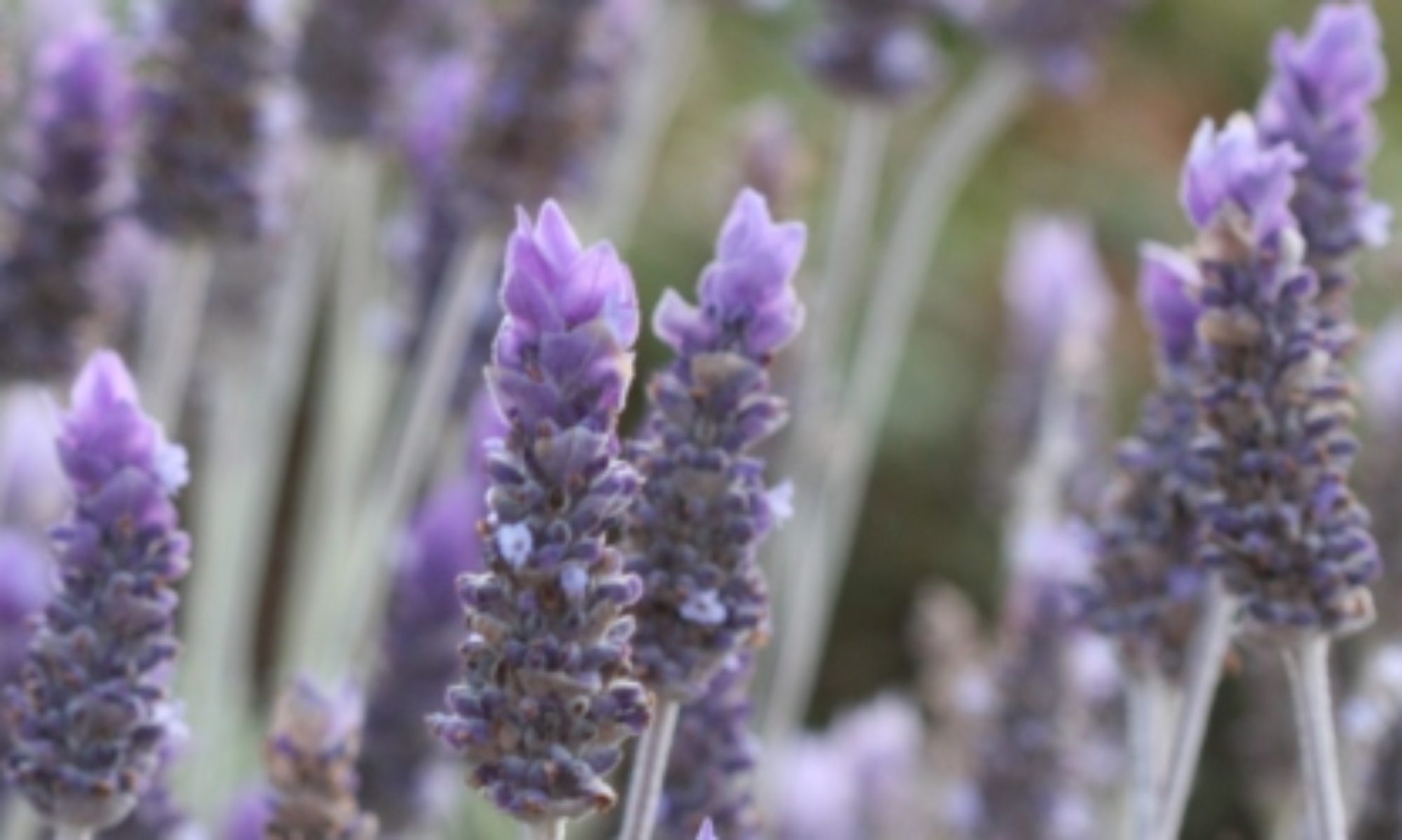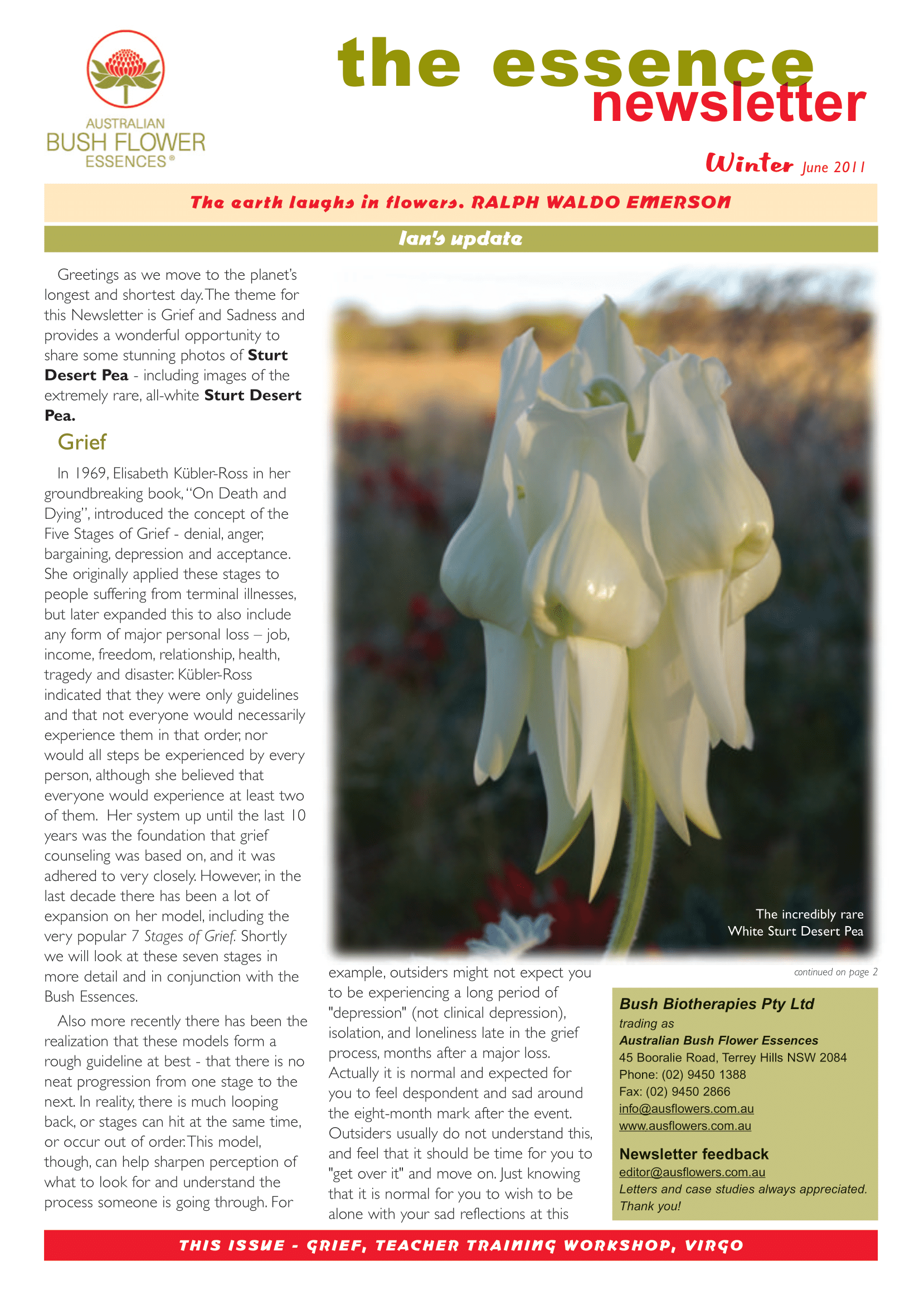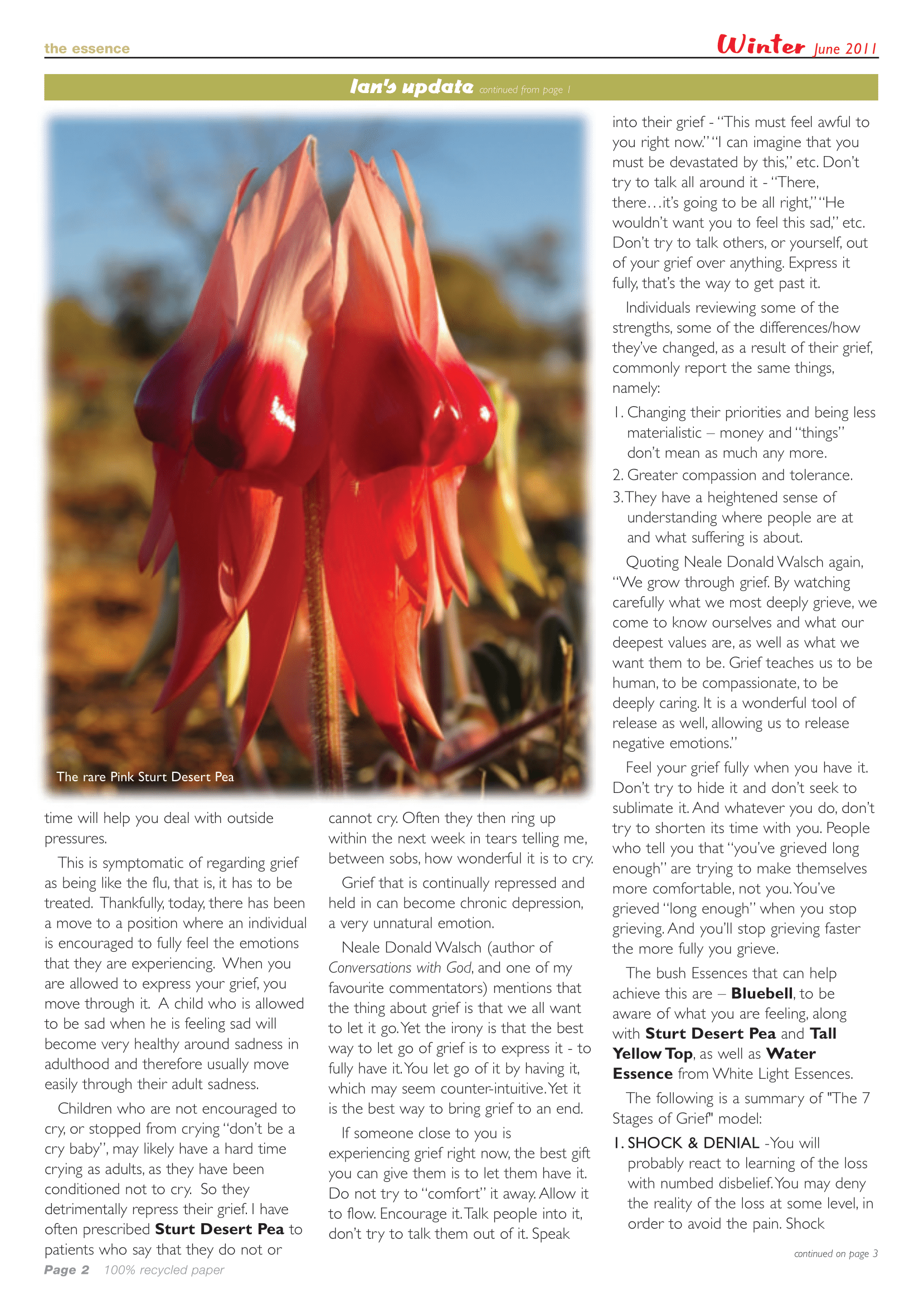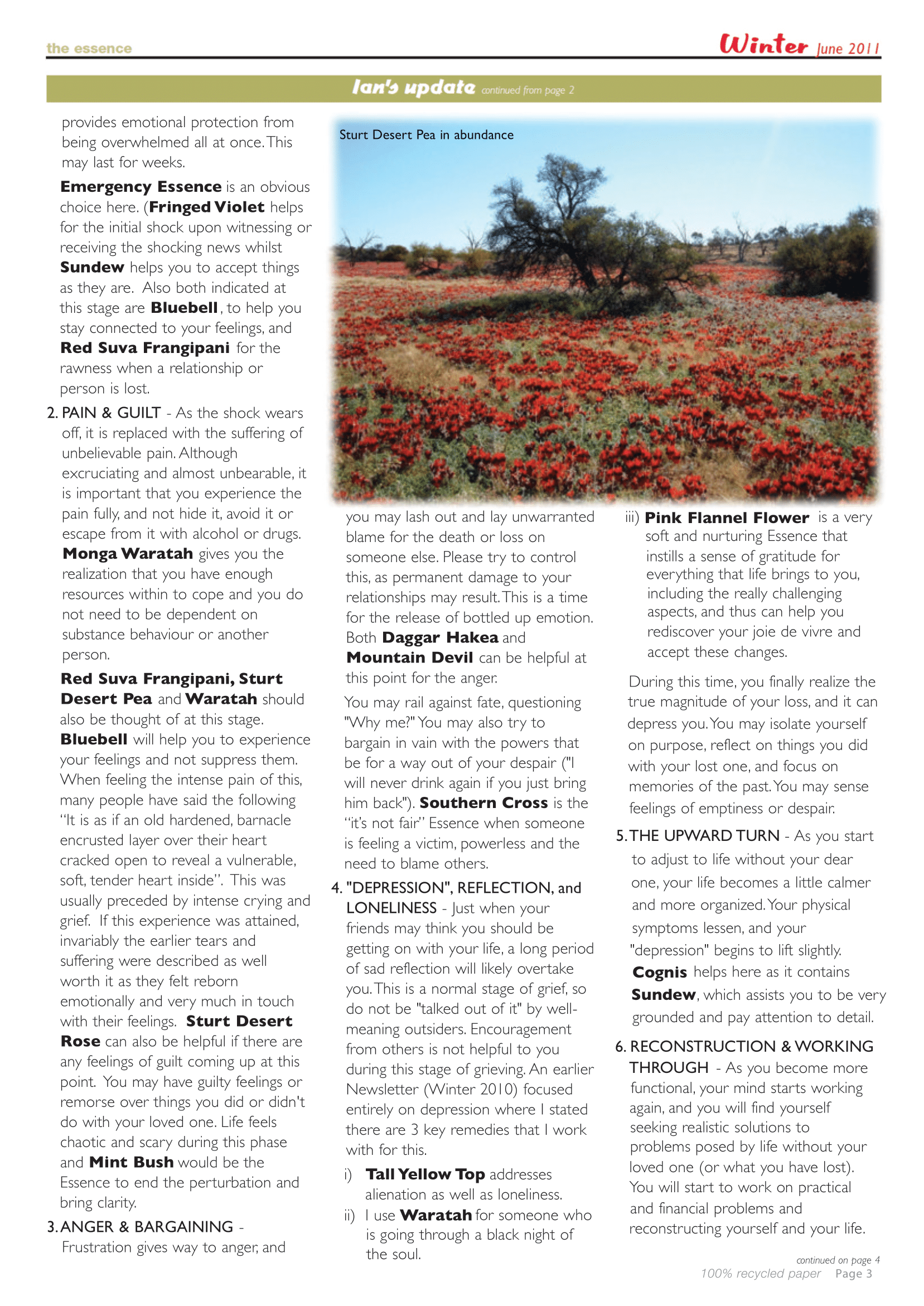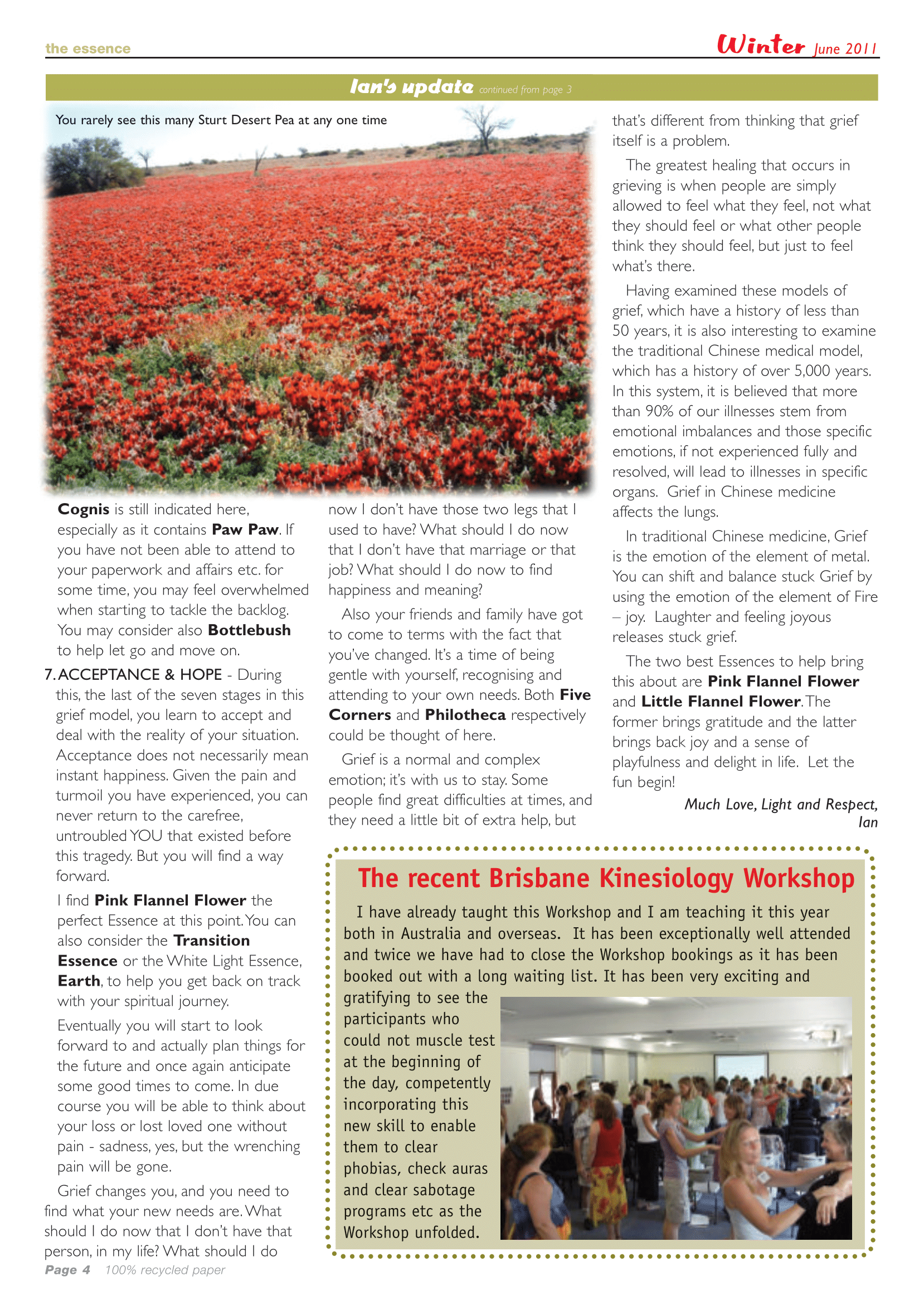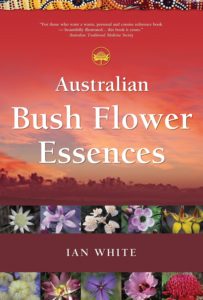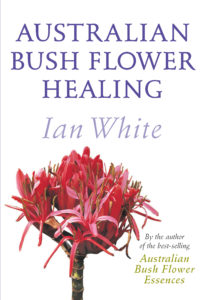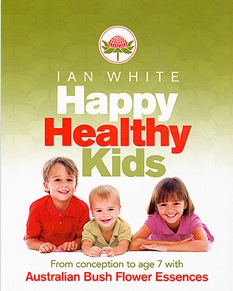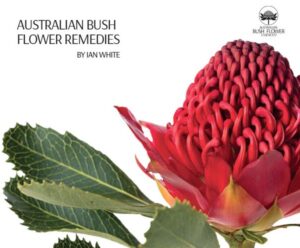Ian White, founder of the Australian Bush Flower Essences, had a subscription newsletter that came out 4 times per year (it’s now free).
Called “The Essence”, it contains a wealth of information on the flower essences, how to use them as well as testimonials. Ian has kindly given me permission to reproduce two of those articles here.
In the Winter June 2011 edition, Ian wrote about Grief, its process, and how that process can be made easier with the use of the Australian Bush Flower Essences.
I thought this article was particularly “close to the bone” for Carers. Many of us can be in a continual state of grief; grief for the life we wish our children could have, but may never be able to achieve, or perhaps grief for the life we envisioned for ourselves that may not be possible.
Essences for Grief
In the September 2019 newsletter, Ian wrote about Grief and Sadness.
- Emergency Essence to help get through the initial shock and hurt of a loss
- Red Suva Frangipani will help the raw emotions immediately after a death or separation
- Sturt Desert Pea is for ongoing, long term hurt and pain
- Pink Flannel Flower for acceptance for the present situation whatever it is, with gratitude
- Bluebell to support the expression of feelings and coping with denial
- Boronia to help where there is pining for who or what has been lost
- Bottlebrush for adapting to the changes that death and separation inevitably bring
- Southern Cross for any sense of ‘poor me’ and to help our move into our own power
- Dagger Hakea dissolves anger that may arise around the death of, or separation from, a loved one
- Little Flannel Flower can help bring back joy and child-like exuberance for life
- Sturt Desert Rose can help if there is any guilt associated with the death or other loss.
- Freshwater Mangrove for being open to completely new ways of thinking
“In 1969, Elisabeth Kübler-Ross in her groundbreaking book, “On Death and Dying”, introduced the concept of the Five Stages of Grief – denial, anger, bargaining, depression and acceptance. She originally applied these stages to people suffering from terminal illnesses, but later expanded this to also include any form of major personal loss – job, income, freedom, relationship, health, tragedy and disaster. Kübler-Ross indicated that they were only guidelines and that not everyone would necessarily experience them in that order, nor would all steps be experienced by every person, although she believed that everyone would experience at least two of them. Her system up until the last 10 years was the foundation that grief counselling was based on, and it was adhered to very closely. However, in the last decade there has been a lot of expansion on her model, including the very popular 7 Stages of Grief. Shortly we will look at these seven stages in more detail and in conjunction with the Bush Essences.
Also, more recently, there has been the realisation that these models form a rough guideline at best – that there is no neat progression from one stage to the next. In reality, there is much looping back, or stages can hit at the same time, or occur out of order. This model, though, can help sharpen perception of what to look for and understand the process someone is going through. For example, outsiders might not expect you to be experiencing a long period of “depression” (not clinical depression), isolation, and loneliness late in the grief process, months after a major loss. Actually it is normal and expected for you to feel despondent and sad around the eight-month mark after the event. Outsiders usually do not understand this, and feel that it should be time for you to “get over it” and move on. Just knowing that it is normal for you to wish to be alone with your sad reflections at this time will help you deal with outside pressures.
This is symptomatic of regarding grief as being like the flu, that is, it has to be treated. Thankfully, today, there has been a move to a position where an individual is encouraged to fully feel the emotions that they are experiencing. When you are allowed to express your grief you are far more likely to quickly move through it. A child who is allowed to be sad when he is feeling sad will become very healthy around sadness in adulthood and therefore usually move easily through their adult sadness.
Children who are not encouraged to cry, stopped from crying or told “don’t be a cry baby”, may likely have a hard time crying as adults, as they have been conditioned not to cry. So they detrimentally repress their grief. I have often prescribed Sturt Desert Pea to patients who say that they do not or cannot cry. Often they then ring up within the next week in tears telling me, between sobs, how wonderful it is to cry.
Grief that is continually repressed and held in can become chronic depression, a very unnatural emotion.
Neale Donald Walsch (author of Conversations with God, and one of my favourite commentators) mentions that the thing about grief is that we all want to let it go. Yet the irony is that the best way to let go of grief is to express it – to fully have it. You let go of it by having it, which may seem counter-intuitive. Yet it is the best way to bring grief to an end.
If someone close to you is experiencing grief right now, the best gift you can give them is to let them have it. Do not try to “comfort” it away. Allow it to flow. Encourage it. Talk people into it, don’t try to talk them out of it. Speak into their grief – “This must feel awful to you right now.” “I can imagine that you must be devastated by this,” etc. Don’t try to talk all around it – “There, there…it’s going to be all right,” “He wouldn’t want you to feel this sad,” etc. Don’t try to talk others, or yourself, out of your grief over anything. Express it fully, that’s the way to get past it.
Individuals reviewing some of the strengths, some of the differences/how they’ve changed, as a result of their grief, commonly report the same things, namely:
- Changing their priorities and being less materialistic – money and “things” don’t mean as much any more.
- Greater compassion and tolerance.
- They have a heightened sense of understanding where people are at and what suffering is about.
Quoting Neale Donald Walsch again, “We grow through grief. By watching carefully what we most deeply grieve, we come to know ourselves and what our deepest values are, as well as what we want them to be. Grief teaches us to be human, to be compassionate, to be deeply caring. It is a wonderful tool of release as well, allowing us to release negative emotions.”
Feel your grief fully when you have it. Don’t try to hide it and don’t seek to sublimate it. And whatever you do, don’t try to shorten its time with you. People who tell you that “you’ve grieved long enough” are trying to make themselves more comfortable, not you. You’ve grieved “long enough” when you stop grieving. And you’ll stop grieving faster the more fully you grieve.
The Bush Essences that can help achieve this are – Bluebell, to be aware of what you are feeling, along with Sturt Desert Pea and Tall Yellow Top, as well as Water Essence from White Light Essences.
The following is a summary of “The 7 Stages of Grief” model:
- SHOCK & DENIAL – You will probably react to learning of the loss with numbed disbelief. You may deny the reality of the loss at some level, in order to avoid the pain. Shock provides emotional protection from being overwhelmed all at once. This may last for weeks.
- Emergency Essence is an obvious choice here. (Fringed Violet helps for the initial shock upon witnessing or receiving the shocking news whilst Sundew helps you to accept things as they are. Also both indicated at this stage are Bluebell, to help you stay connected to your feelings, and Red Suva Frangipani for the rawness when a relationship or person is lost.
2. PAIN & GUILT – As the shock wears off, it is replaced with the suffering of unbelievable pain. Although excruciating and almost unbearable, it is important that you experience the pain fully, and not hide it, avoid it or escape from it with alcohol or drugs. Monga Waratah gives you the realisation that you have enough resources within to cope and you do not need to be dependent on substance behaviour or another person.
- Red Suva Frangipani, Sturt Desert Pea and Waratah should also be thought of at this stage. Bluebell will help you to experience your feelings and not suppress them. When feeling the intense pain of this, many people have said the following “It is as if an old hardened, barnacle encrusted layer over their heart cracked open to reveal a vulnerable, soft, tender heart inside”. This was usually preceded by intense crying and grief. If this experience was attained, invariably the earlier tears and suffering were described as well worth it as they felt reborn emotionally and very much in touch with their feelings. Sturt Desert Rose can also be helpful if there are any feelings of guilt coming up at this point. You may have guilty feelings or remorse over things you did or didn’t do with your loved one. Life feels chaotic and scary during this phase and Mint Bush would be the Essence to end the perturbation and bring clarity.

3. ANGER & BARGAINING – Frustration gives way to anger, and you may lash out and lay unwarranted blame for the death or loss on someone else. Please try to control this, as permanent damage to your relationships may result. This is a time for the release of bottled up emotion.
- Both Dagger Hakea and Mountain Devil can be helpful at this point for the anger.
- You may rail against fate, questioning “Why me?” You may also try to bargain in vain with the powers that be for a way out of your despair (“I will never drink again if you just bring him back”). Southern Cross is the “it’s not fair” Essence when someone is feeling a victim, powerless and the need to blame others.
4. DEPRESSION, REFLECTION, and LONELINESS – Just when your friends may think you should be getting on with your life, a long period of sad reflection will likely overtake you. This is a normal stage of grief, so do not be “talked out of it” by well-meaning outsiders. Encouragement from others is not helpful to you during this stage of grieving. An earlier Newsletter (Winter 2010) focused entirely on depression where I stated there are 3 key remedies that I work with for this.
- Tall Yellow Top addresses alienation as well as loneliness. It is my first choice for depression.
- I use Waratah for someone who is going through a black night of the soul, total despair and for those who are suicidal.
- Pink Flannel Flower is a very soft and nurturing Essence that instills a sense of gratitude for everything that life brings to you, including the really challenging aspects, and thus can help you rediscover your joie de vivre and accept these changes.
During this time, you finally realize the true magnitude of your loss, and it can depress you. You may isolate yourself on purpose, reflect on things you did with your lost one, and focus on memories of the past. You may sense feelings of emptiness or despair.
5. THE UPWARD TURN – As you start to adjust to life without your dear one, your life becomes a little calmer and more organized. Your physical symptoms lessen, and your “depression” begins to lift slightly.
- Cognis helps here as it contains Sundew, which assists you to be very grounded and pay attention to detail.
6. RECONSTRUCTION & WORKING THROUGH – As you become more functional, your mind starts working again, and you will find yourself seeking realistic solutions to problems posed by life without your loved one (or what you have lost). You will start to work on practical and financial problems and reconstructing yourself and your life.
- Cognis is still indicated here, especially as it contains Paw Paw. If you have not been able to attend to your paperwork and affairs etc. for some time, you may feel overwhelmed when starting to tackle the backlog. You may consider also Bottlebush to help let go and move on.
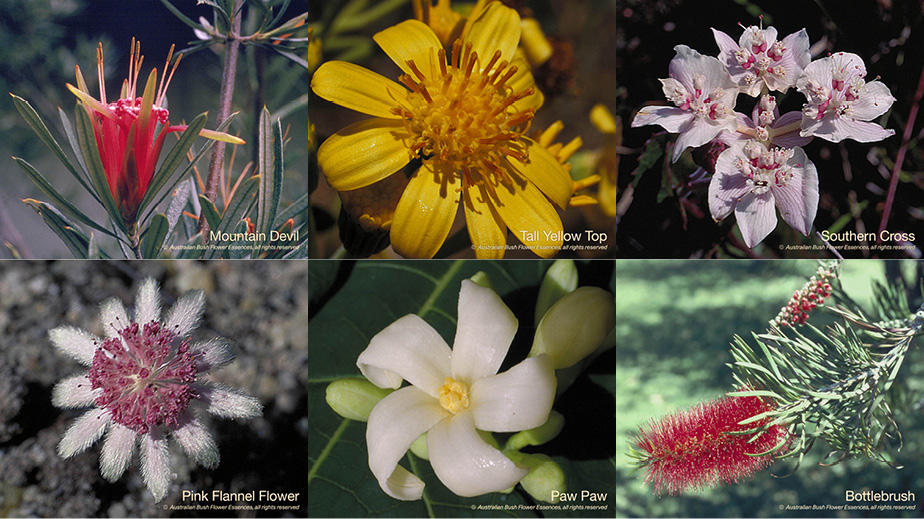
7. ACCEPTANCE & HOPE – During this, the last of the seven stages in this grief model, you learn to accept and deal with the reality of your situation. Acceptance does not necessarily mean instant happiness. Given the pain and turmoil you have experienced, you can never return to the carefree, untroubled YOU that existed before this tragedy. But you will find a way forward.
- I find Pink Flannel Flower the perfect Essence at this point. You can also consider the Transition Essence or the White Light Essence, Earth, to help you get back on track with your spiritual journey.
Eventually you will start to look forward to and actually plan things for the future and once again anticipate some good times to come. In due course you will be able to think about your loss or lost loved one without pain – sadness, yes, but the wrenching pain will be gone.
In the August 2019 newsletter, Marie Matthews, a previous newsletter editor and author of Animal Healing and ABFE shares a lifetime of insights on Death and Dying.
References
Australian Bush Flower Essences
Phone: (02) 9450 1388
Back to top